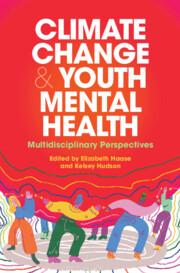Book contents
- Climate Change and Youth Mental Health
- Climate Change and Youth Mental Health
- Copyright page
- Contents
- Figures
- Tables
- Textboxes
- Contributors
- Preface and Introduction
- Considerations
- Acknowledgments
- Part I Conceptual Foundations of Climate Distress in Young People
- Chapter 1 Climate Distress among Young People
- Chapter 2 Definitions and Conceptualizations of Climate Distress
- Chapter 3 Psychiatric Perspectives on Youth Climate Distress
- Chapter 4 Developmental Perspectives on Understanding and Responding to Mental Health Impacts of Climate Change on Young People
- Chapter 5 Neuropsychiatric Perspectives on the Biology of Anxiety and Youth Climate Distress
- Chapter 6 Psychoanalytic and Relational Perspectives on Youth Climate Distress
- Chapter 7 Understanding the Role of Trauma and Dissociation in Youth Responses to Climate Crises
- Chapter 8 Cognitive Behavioral Principles for Conceptualizing Young People’s Eco-Emotions and Eco-Distress
- Chapter 9 A Research Agenda for Young People’s Psychological Response to Climate Change
- Part II Multidisciplinary Perspectives on Youth Climate Distress
- Appendix A Resource List for Educators
- Appendix B Costs and Benefits of Activism Scale
- Index
- References
Chapter 7 - Understanding the Role of Trauma and Dissociation in Youth Responses to Climate Crises
Eco-Neglect as Institutional Child Abuse
from Part I - Conceptual Foundations of Climate Distress in Young People
Published online by Cambridge University Press: 06 June 2024
- Climate Change and Youth Mental Health
- Climate Change and Youth Mental Health
- Copyright page
- Contents
- Figures
- Tables
- Textboxes
- Contributors
- Preface and Introduction
- Considerations
- Acknowledgments
- Part I Conceptual Foundations of Climate Distress in Young People
- Chapter 1 Climate Distress among Young People
- Chapter 2 Definitions and Conceptualizations of Climate Distress
- Chapter 3 Psychiatric Perspectives on Youth Climate Distress
- Chapter 4 Developmental Perspectives on Understanding and Responding to Mental Health Impacts of Climate Change on Young People
- Chapter 5 Neuropsychiatric Perspectives on the Biology of Anxiety and Youth Climate Distress
- Chapter 6 Psychoanalytic and Relational Perspectives on Youth Climate Distress
- Chapter 7 Understanding the Role of Trauma and Dissociation in Youth Responses to Climate Crises
- Chapter 8 Cognitive Behavioral Principles for Conceptualizing Young People’s Eco-Emotions and Eco-Distress
- Chapter 9 A Research Agenda for Young People’s Psychological Response to Climate Change
- Part II Multidisciplinary Perspectives on Youth Climate Distress
- Appendix A Resource List for Educators
- Appendix B Costs and Benefits of Activism Scale
- Index
- References
Summary
Humans have evolved as a species with unique capabilities to destroy this world that we inhabit. Some of this destructiveness is a function of a loss of embodied wisdom and a dissociative disconnection from the complex systems of life on the planet. Inaction about climate change is a failure to protect our children and can be considered institutional child abuse. Climate disasters, along with other social injustices, traumatize all life on the planet, and disproportionately impact those already struggling with loss of community support. Fostering posttraumatic wisdom in youth requires recognition that some are vulnerable to maladaptive psychic numbing, while others manifest a resilience born from imagination and creativity.
Keywords
- Type
- Chapter
- Information
- Climate Change and Youth Mental HealthMultidisciplinary Perspectives, pp. 130 - 147Publisher: Cambridge University PressPrint publication year: 2024

